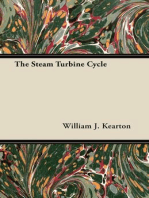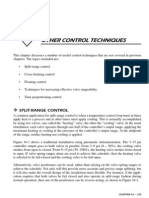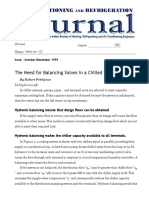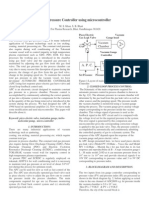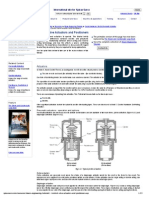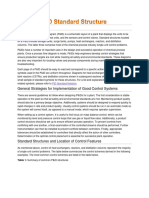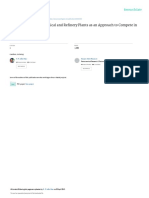Controllers and Final Control Elements: 24/12/2016 Dr. Arkan Jasim Hadi 1
Controllers and Final Control Elements: 24/12/2016 Dr. Arkan Jasim Hadi 1
Uploaded by
کبری ادریس رسولCopyright:
Available Formats
Controllers and Final Control Elements: 24/12/2016 Dr. Arkan Jasim Hadi 1
Controllers and Final Control Elements: 24/12/2016 Dr. Arkan Jasim Hadi 1
Uploaded by
کبری ادریس رسولOriginal Title
Copyright
Available Formats
Share this document
Did you find this document useful?
Is this content inappropriate?
Copyright:
Available Formats
Controllers and Final Control Elements: 24/12/2016 Dr. Arkan Jasim Hadi 1
Controllers and Final Control Elements: 24/12/2016 Dr. Arkan Jasim Hadi 1
Uploaded by
کبری ادریس رسولCopyright:
Available Formats
CHAPTER 9
CONTROLLERS AND FINAL CONTROL ELEMENTS
This chapter will focus attention on the controller and final control element and will discuss the dynamic
characteristics of some of these components that are in common use. As shown in Fig. 8–2, the input signal to the
controller is the error, and the output signal of the controller is fed to the final control element. In many process
control systems, this output signal is an air pressure, and the final control element is a pneumatic valve that opens
and closes as the air pressure on the diaphragm changes.
For the mathematical analysis of control systems, it is sufficient to regard the controller as a simple computer. For
example, a proportional controller may be thought of as a device that receives the error signal and puts out a signal
proportional to it. Similarly, the final control element may be regarded as a device that produces corrective
action on the process. The corrective action is regarded as mathematically related to the output signal from the
controller. However, it is desirable to have some appreciation of the actual physical mechanisms used to accomplish
this. For this reason, we begin this chapter with a physical description of a pneumatic control valve and a simplified
description of a proportional controller.
24/12/2016 Dr. ARKAN JASIM HADI 1
9.1 MECHANISMS
Control Valve
The control valve shown in Fig. 9–1 contains a pneumatic device (valve motor) that moves the valve stem as the
pressure on a spring-loaded diaphragm changes. The stem positions a plug in the orifice of the valve body. In the air-
to-close valve, as the air pressure increases, the plug moves downward and restricts the flow of fluid through the
valve. In the air-to-open valve, the valve opens and allows greater flow as the valve-top air pressure increases. The
choice between air-to-open and air-to-close is usually made based on safety considerations. If the instrument air
pressure fails, we would like the valve to fail in a safe position for the process. For example, if the control valve were
on the cooling water inlet to a cooling jacket for an exothermic chemical reactor, we would want the valve to fail open
so that we do not lose cooling water flow to the reactor. In such a situation, we would choose an air-to-close valve.
24/12/2016 Dr. ARKAN JASIM HADI 2
Valve motors are often constructed so that the valve stem position is proportional to the valve-top pressure. Most commercial
valves move from fully open to fully closed as the valve-top pressure changes from 3 to 15 psig.
In general, the flow rate of fluid through the valve depends upon the upstream and downstream fluid pressures and the size of the
opening through the valve. The plug and seat (or orifice) can be shaped so that various relationships between stem position and
size of opening (hence, flow rate) are obtained. In our example, we assume for simplicity that at steady state the flow (for fixed
upstream and downstream fluid pressures) is proportional to the valve-top pneumatic pressure. A valve having this relation is
called a linear valve. A more complete discussion of control valves is presented in Chap. 19.
Controller
The control hardware required to control the temperature of a stream leaving a heat exchanger is shown in Fig. 9–2 .
This hardware consists of the following components listed here along with their respective conversions:
1. Transducer (temperature-to-current)
2. Computer/ Controller (current-to-current)
3. Converter (current-to-pressure)
4. Control valve (pressure-to-flow rate)
24/12/2016 Dr. ARKAN JASIM HADI 3
Figure 9–2 shows that a thermocouple is used to measure the
temperature; the signal from the thermocouple is sent to a
transducer, which produces a current output in the range of 4 to 20
mA, which is a linear function of the input.
The output of the transducer enters the controller where it is
compared to the set point to produce an error signal. The
computer/controller converts the error to an output signal in the
range of 4 to 20 mA in accordance with the computer control
algorithm. The only control algorithm we have considered so far
has been proportional.
The output of the computer/controller enters the converter, which
produces an output in the range of 3 to 15 psig, as a linear function
of the input.
Finally, the air pressure output of the converter is sent to the top
of the control valve, which adjusts the flow of steam to the heat
exchanger.
We assume that the valve is linear and is the air-to-open type. The external power (120 V) needed for each component is also
shown in Fig. 9–2 . Electricity is needed for the transducer, computer/controller, and converter. A source of 20 psig air is also
needed for the converter.
24/12/2016 Dr. ARKAN JASIM HADI 4
To see how the components interact with one another, consider the process to be operating at steady state with the
outlet temperature equal to the set point. If the temperature of the cold process stream decreases, the following
events occur: After some delay the thermocouple detects a decrease in the outlet temperature and produces a
proportional change in the signal to the controller. As soon as the controller detects the drop in temperature, relative
to the set point, the controller output increases according to proportional action. The increase in signal to the
converter causes the output pressure from the converter to increase and to open the valve wider to admit a greater
flow of the hot process stream. The increased flow of hot stream will eventually increase the output temperature and
move it toward the set point.
From this qualitative description, we see that the flow of signals from one component to the next is such that the
outlet temperature of the heat exchanger should return toward the set point. An equivalent P&ID (piping and
instrumentation diagram) for this control system is shown in Fig. 9–3 (for other P&ID symbols, see App. 9A).
24/12/2016 Dr. ARKAN JASIM HADI 5
For convenience in describing various control laws (or
algorithms) in the next part of this chapter, the transducer,
controller, and converter will be lumped into one block, as
shown in Fig. 9–4 .
This concludes our brief introduction to valves and controllers. We now
present transfer functions for such devices. These transfer functions,
especially for controllers, are based on ideal devices that can be only
approximated in practice. The degree of approximation is sufficiently good
to warrant use of these transfer functions to describe the dynamic behavior
of controller mechanisms for ordinary design purposes.
24/12/2016 Dr. ARKAN JASIM HADI 6
9.2 IDEAL TRANSFER FUNCTIONS
Control Valve
A pneumatic valve always has some dynamic lag, which means that the stem position does not respond
instantaneously to a change in the applied pressure from the controller. From experiments conducted on pneumatic
valves, it has been found that the relationship between flow and valve-top pressure for a linear valve can often be
represented by a first-order transfer function; thus
where Kv is the steady-state gain, i.e., the constant of proportionality between the steady state flow rate and the
valve-top pressure, and 𝜏v is the time constant of the valve.
In many practical systems, the time constant of the valve is very small when compared with the time constants of
other components of the control system, and the transfer function of the valve can be approximated by a constant.
Under these conditions, the valve is said to contribute negligible dynamic lag.
24/12/2016 Dr. ARKAN JASIM HADI 7
To justify the approximation of a fast valve by a transfer function, which is simply Kv, consider a first-order valve and a
first-order process connected in series, as shown in Fig. 9–5 .
According to the discussion of Chap. 6, if we assume no
interaction (which is generally valid for this case), the
relationship between the air pressure to the valve and the
output from the process (perhaps a reactor temperature) is
For a unit-step change in the valve-top pressure P,
the inverse of which is
If 𝜏𝑣 ≪ 𝜏𝑃 , this equation is approximately
The last expression is the unit-step response of the transfer function
24/12/2016 Dr. ARKAN JASIM HADI 8
so that the combination of process and valve is essentially first-order. This clearly demonstrates that when the time
constant of the valve is much smaller than that of the process, the valve transfer function can be taken as Kv
A typical pneumatic valve has a time constant of the order of 1 s. Many industrial processes behave as first-order
systems or as a series of first-order systems having time constants that may range from a minute to an hour. For
these systems we have shown that the lag of the valve is negligible, and we will make frequent use of this
approximation.
Controllers
In this section, we present the transfer functions for the controllers frequently used in industrial processes. Because
the transducer and the converter will be lumped together with the controller for simplicity, the result is that the input
will be the measured variable x (e.g., temperature and fluid level) and the output will be a pneumatic signal p.
(See Fig. 9–4 .) Actually this form ( x as input and p as output) applies to a pneumatic controller. For convenience, we
will refer to the lumped components as the controller in the following discussion, even though the actual electronic
controller is but one of the components.
PROPORTIONAL CONTROL. The simplest type of controller is the proportional controller. (The ON/OFF control is really
the simplest, but it is a special case of the proportional controller as we’ll see shortly.) Our goal is to reduce the error
between the process output and the set point. The proportional controller, as we will see, can reduce the error, but
cannot eliminate it. If we can accept some residual error, proportional control may be the proper choice for the
situation.
24/12/2016 Dr. ARKAN JASIM HADI 9
The proportional controller has only one adjustable parameter, the controller gain.
The proportional controller produces an output signal (pressure in the case of a pneumatic controller, current, or
voltage for an electronic controller) that is proportional to the error 𝜀. This action may be expressed as
where p = output signal from controller, psig or mA
Kc = proportional gain, or sensitivity
𝜀 = error = (set point) - (measured variable)
ps = a constant, the steady-state output from the controller [the bias value, see Eqs. (8.19) and (8.23)]
The units of the set point and the measured variable must be the same
In a controller having adjustable gain, the value of the gain Kc can be varied by entering it into the controller,
usually by means of a keypad (or a knob on older equipment).
The value of ps is the value of the output signal when 𝜀 is zero, and in most controllers ps can be adjusted to obtain
the required output signal when the control system is at steady state and 𝜀 = 0.
To obtain the transfer function of Eq. (9.3), we first introduce the deviation variable
24/12/2016 Dr. ARKAN JASIM HADI 10
into Eq. (9.3). At time t = 0, we assume the error 𝜀 s to be zero. Then 𝜀 is already a deviation variable. Equation (9.3)
becomes
Taking the transform of Eq. (9.4) gives the transfer function of an ideal proportional controller.
The actual behavior of a proportional controller is depicted in Fig. 9–6 . The controller output will saturate (level out) at
pmax =15 psig or 20 mA at the upper end and at pmin = 3 psig or 4 mA at the lower end of the output. The ideal transfer
function Eq. (9.5) does not predict this saturation phenomenon.
FIGURE 9–6
Proportional controller output as
a function of error input to the
controller. (a) Ideal behavior;
(b) actual behavior.
24/12/2016 Dr. ARKAN JASIM HADI 11
Example 9.1. A pneumatic proportional controller is used in the process shown in Fig. 9–2 to control the cold stream
outlet temperature within the range of 60 to 120 oF. The controller gain is adjusted so that the output pressure goes
from 3 psig (valve fully closed) to 15 psig (valve fully open) as the measured temperature goes from 71 to 75 oF with
the set point held constant. Find the controller gain Kc
Now assume that the gain of the controller is changed to 0.4 psi/ oF. Find the error in temperature that will cause
the control valve to go from fully closed to fully open.
At this level of gain, the valve will be fully open if the error signal reaches 30 oF. The gain Kc has the units of psi per
unit of measured variable. [Regarding the units on controller gain, if the actual controller of Fig. 9–4 is considered,
both the input and the output units are in milliamperes. In this case the gain will be dimensionless (i.e., mA/mA).]
24/12/2016 Dr. ARKAN JASIM HADI 12
ON/OFF CONTROL. A special case of proportional control is on/off control. If the gain Kc is made very high, the valve
will move from one extreme position to the other if the process deviates only slightly from the set point. This very
sensitive action is called on/ off action because the valve is either fully open (on) or fully closed (off); i.e., the valve
acts as a switch. This is a very simple controller and is exemplified by the thermostat used in a home-heating system.
PROPORTIONAL-INTEGRAL (PI) CONTROL. If we cannot tolerate any residual error, we will have to introduce an
additional control mode: integral control. If we add integral control to our proportional controller, we have what is
termed PI, or proportional-integral control. The integral mode ultimately drives the error to zero. This controller has
two adjustable parameters for which we select values, the gain and the integral time. Thus it is a bit more complicated
than a proportional controller, but in exchange for the additional complexity, we reap the advantage of no error at
steady state.
PI control is described by the relationship
where Kc = proportional gain
𝜏𝐼 = integral time, min
ps = constant (the bias value)
In this case, we have added to the proportional action term 𝐾𝑐 𝜀 another term that is proportional to the integral of
the error. The values of Kc and 𝜏𝐼 are both adjustable.
24/12/2016 Dr. ARKAN JASIM HADI 13
To visualize the response of this controller, consider the response to a unit-step change in error, as shown in Fig. 9-8.
This unit-step response is most directly obtained by inserting 𝜀 =1 into Eq. (9.6), which yields
Notice that p changes suddenly by an amount Kc and then
changes linearly with time at a rate Kc /𝜏𝐼 .
To obtain the transfer function of Eq. (9.6), we again
introduce the deviation variable P = p- ps into Eq. (9.6)
and then take the transform to obtain
Some manufacturers prefer to use the term reset rate, which is defined as the reciprocal of 𝜏𝐼 . The integral
adjustment on a controller may be denoted by integral time or reset rate (carefully check the specific controller to
be sure which value to enter). The calibration of the proportional and integral action is often checked by observing
the jump and slope of a step response, as shown in Fig. 9–8 .
24/12/2016 Dr. ARKAN JASIM HADI 14
PROPORTIONAL-DERIVATIVE (PD) CONTROL. Derivative control is another mode that can be added to our
proportional or proportional-integral controllers. It acts upon the derivative of the error, so it is most active when the
error is changing rapidly. It serves to reduce process oscillations.
This mode of control may be represented by
where Kc = proportional gain
𝜏𝐷 = derivative time, min
ps = constant (bias value)
In this case, we have added to the proportional term another term
𝐾𝑐 𝜏𝐷 𝑑𝜀/𝑑𝑡, which is proportional to the derivative of the error. The
values of Kc and 𝜏𝐷 are both adjustable. Other terms that are used to
describe the derivative action are rate control and anticipatory
control.
The action of this controller can be visualized by considering the response to a linear change in error as shown in
Fig. 9–9 .
Notice that p changes suddenly by an amount AKc 𝜏𝐷 as a result of the derivative action and then changes linearly
at a rate AKc. The effect of derivative action in this case is to anticipate the linear change in error by adding output
AKc 𝜏𝐷 to the proportional action.
24/12/2016 Dr. ARKAN JASIM HADI 15
This response is obtained by introducing the linear function 𝜀 𝑡 = 𝐴 𝑡 into Eq. (9.9) to obtain
To obtain the transfer function of Eq. (9.9), we again introduce the deviation variable P = p- ps into Eq. (9.9) and then
take the transform to obtain
PROPORTIONAL-INTEGRAL-DERIVATIVE (PID) CONTROL. This mode of control is a combination of the previous modes
and is given by the expression
In this case, all three values Kc , 𝜏𝐷 , and 𝜏𝐼 can be adjusted in the controller. The transfer function for this controller
can be obtained from the Laplace transform of Eq. (9.11); thus
24/12/2016 Dr. ARKAN JASIM HADI 16
Motivation for Addition of Integral and Derivative Control Modes
The curves of Fig. 9–10 show the behavior of a typical feedback control system using different kinds of control when it
is subjected to a permanent disturbance. This may be visualized in terms of the stirred-tank temperature control
system of Chap. 8 after a step change in Ti. The value of the controlled variable is seen to rise at time zero
owing to the disturbance. With no control, this variable continues to rise to a new steady-state value. With control, after
some time the control system begins to take action to try to maintain the controlled variable close to the value that
existed before the disturbance occurred.
With proportional action only, the control system is able to
arrest the rise of the controlled variable and ultimately
bring it to rest at a new steady-state value. The difference
between this new steady-state value and the original
value (the set point, in this case) is called offset. For the
particular system shown, the offset is seen to be only
about 20 percent of the ultimate change that would have
been realized for this disturbance in the absence of
control.
As shown by the PI curve, the addition of integral action
eliminates the offset; the controlled variable ultimately
returns to the original value. This advantage of integral
action is balanced by the disadvantage of a more
oscillatory behavior.
24/12/2016 Dr. ARKAN JASIM HADI 17
The addition of derivative action to the PI action gives a definite improvement in the response. The rise of the
controlled variable is arrested more quickly, and it is returned rapidly to the original value with little or no oscillation.
The selection among the control systems whose responses are shown in Fig. 9–10 depends on the particular
application. If an offset of about 20 percent is tolerable, proportional action would likely be selected. If no offset were
tolerable, integral action would be added. If excessive oscillations had to be eliminated, derivative action might
be added. The addition of each mode means, as we will see in later chapters, more difficult controller adjustment.
24/12/2016 Dr. ARKAN JASIM HADI 18
Chapter 9
CAPSULE SUMMARY
CONTROL VALVES
Two basic types of control valves are air-to-close
and air-to-open. The air pressure (pneumatic) signal
is usually 3 to 15 psig. The dynamics of the valves
are adequately modeled as first-order systems. The
time constant is on the order of 1 s.
24/12/2016 Dr. ARKAN JASIM HADI 19
CONTROLLERS
For more control systems we can see appendix 9A and the lectures for control examples
24/12/2016 Dr. ARKAN JASIM HADI 20
PIPING AND INSTRUMENTATION DIAGRAM SYMBOLS
Piping and instrumentation diagrams (P&IDs) are used by the chemical process industry to document the control
systems for their processes. The Instrument Society of America (ISA) produces a standards document [ISA-5.1-
1984-(R1992)] “Instrument Symbols and Identification” that establishes a uniform means of designating instruments,
control systems, and sensors used for measurement and control in a process. The standard is suitable for use in
the chemical, petroleum, power generation, air conditioning, metal refining, and numerous other process industries.
Table 9A.1 shows some common conventions used for identifying process instrumentation and control on
process drawings. Figure 9A–1 shows an example of a level control loop for a process tank.
24/12/2016 Dr. ARKAN JASIM HADI 21
Figure 9A–1 shows an example of a level control loop for
a process tank. The operation is as follows. The tank
level is measured using a sensor, perhaps a differential
pressure cell, indicated by the bubble containing LE on
the diagram. The sensor is connected to a level
transmitter, LT, that sends an electrical signal (4 to 20 mA)
to a level indicating controller LIC. Level alarms high and
low, LAH and LAL, “monitor” the signal from the level
transmitter and indicate an alarm situation if necessary.
Notice from the symbols (the line through the bubble) that
LIC, LAH, and LAL are all located in the control room,
while LE and LT are mounted in the field. The level
indicating controller determines the necessary signal to
send to the valve, based on the current level in the tank,
the set point, and the selected control algorithm being
used (P or PID, for example). LY computes the necessary
control air pressure signal (3 to 15 psig) to send to the
level control valve LCV to properly respond to the
controller output signal from LIC.
24/12/2016 Dr. ARKAN JASIM HADI 22
24/12/2016 Dr. ARKAN JASIM HADI 23
24/12/2016 Dr. ARKAN JASIM HADI 24
24/12/2016 Dr. ARKAN JASIM HADI 25
24/12/2016 Dr. ARKAN JASIM HADI 26
24/12/2016 Dr. ARKAN JASIM HADI 27
You might also like
- When Failsafe Isn't Enough - Volume Tank Sizing (Process Automation January 2009)Document8 pagesWhen Failsafe Isn't Enough - Volume Tank Sizing (Process Automation January 2009)Manual Source100% (1)
- Voyagers: Game of Flames (Book 2) by Robin WassermanDocument35 pagesVoyagers: Game of Flames (Book 2) by Robin WassermanRandom House KidsNo ratings yet
- Controlled ExtractionDocument5 pagesControlled ExtractionNuri Leal100% (4)
- Guidelines For Selecting The Proper Valve CharacteristicDocument6 pagesGuidelines For Selecting The Proper Valve CharacteristicIamPedro100% (1)
- The Control System: Error - TDocument15 pagesThe Control System: Error - Tکبری ادریس رسولNo ratings yet
- 02 Control ValvesDocument10 pages02 Control ValvesPoint LogNo ratings yet
- Chapter 9Document17 pagesChapter 9Sagar PawarNo ratings yet
- VPT-Kalatjari (Sazeh Engineering Consultants)Document16 pagesVPT-Kalatjari (Sazeh Engineering Consultants)cristianNo ratings yet
- 1815 16 PDFDocument17 pages1815 16 PDFsiamak001No ratings yet
- Control Valve Selection For Hydraulic SystemsDocument7 pagesControl Valve Selection For Hydraulic SystemszodedNo ratings yet
- PC LabManual 2024Document44 pagesPC LabManual 2024sathavaravishal987No ratings yet
- Pressure Control TrainerDocument44 pagesPressure Control TrainerAjeet KumarNo ratings yet
- Cascade ControlDocument26 pagesCascade ControlIwan R S100% (1)
- Auto1 Kupe5 Co1 Week 5 6 ResurreccionDocument40 pagesAuto1 Kupe5 Co1 Week 5 6 ResurreccionRency ResurreccionNo ratings yet
- Some Aspects of Numerical Simulation of Control Valves For Steam TurbinesDocument1 pageSome Aspects of Numerical Simulation of Control Valves For Steam TurbinesSharat ChandraNo ratings yet
- Control Valve SelectionDocument7 pagesControl Valve SelectionatiqulaNo ratings yet
- The Need For Balancing Valves in A Chilled Water SystemDocument50 pagesThe Need For Balancing Valves in A Chilled Water SystemNoushad P Hamsa100% (1)
- Need For Balancing ValvesDocument12 pagesNeed For Balancing ValvesBubai111No ratings yet
- Anti Surge ControlDocument7 pagesAnti Surge Controlachueth100% (3)
- Compressor SurgeDocument5 pagesCompressor Surges1308b100% (3)
- Vana Seçimi Control Valve Selection Practical GuideDocument7 pagesVana Seçimi Control Valve Selection Practical GuideÖmer EmelNo ratings yet
- W7ADocument15 pagesW7AShujah RashidNo ratings yet
- Lecture VI - PID Controller in Pneumatic System (Use Case)Document21 pagesLecture VI - PID Controller in Pneumatic System (Use Case)R.W. Saputra100% (2)
- Process Control Lab ManualDocument19 pagesProcess Control Lab ManualAnkit Singh100% (1)
- Instrumentation Process 2014.12.31 PDFDocument14 pagesInstrumentation Process 2014.12.31 PDFFadlul RamadhanNo ratings yet
- Control Valve SizingDocument18 pagesControl Valve SizingdidikosanNo ratings yet
- FlowCon PICV Write OutDocument17 pagesFlowCon PICV Write OutmajortayNo ratings yet
- Lab Manual: Instrumentation and ControlDocument42 pagesLab Manual: Instrumentation and ControlJu Naid MalikNo ratings yet
- Hwange Power Station: November 2022 ReportDocument16 pagesHwange Power Station: November 2022 ReportDennis MuzilaNo ratings yet
- Indian Institute of Technology (Indian School of Mines) DhanbadDocument10 pagesIndian Institute of Technology (Indian School of Mines) DhanbadSandeep ReddyNo ratings yet
- Control Valve DPDocument8 pagesControl Valve DPAmit Sawant100% (1)
- Kontrol PneumatikDocument18 pagesKontrol PneumatikM SONY JAYA WISUDANo ratings yet
- Basic Pnue PDFDocument14 pagesBasic Pnue PDFmetal_dung2No ratings yet
- Basic Process ControlDocument38 pagesBasic Process ControlBoris bryan AletanuNo ratings yet
- PVM1Document4 pagesPVM1silverfurNo ratings yet
- How Does A Pneumatic Solenoid Valve WorkDocument4 pagesHow Does A Pneumatic Solenoid Valve Worksushant_jhawerNo ratings yet
- Air SysDocument11 pagesAir Syspbhat83No ratings yet
- Control Valve Actuators and PositionersDocument13 pagesControl Valve Actuators and PositionersRahul LavandNo ratings yet
- Valve Positioners Offer Improved Control Valve PerformanceDocument10 pagesValve Positioners Offer Improved Control Valve PerformanceLeonardo FernándezNo ratings yet
- Ac 2013 FinDocument15 pagesAc 2013 FinRay WangNo ratings yet
- Working Principle of Control Valve With DiagramDocument10 pagesWorking Principle of Control Valve With DiagramKhamis AfendiNo ratings yet
- Lab5-Fluid MechanicsDocument8 pagesLab5-Fluid Mechanicsmsohaib0088No ratings yet
- Final - PID PaperDocument17 pagesFinal - PID PaperAhmed KhairiNo ratings yet
- Common Terms Used With Control ValveDocument4 pagesCommon Terms Used With Control ValveMohamed RezkNo ratings yet
- Control InstDocument481 pagesControl InstEnas Al-khawaldehNo ratings yet
- Laftah/15/ Azeez (HusseinDocument17 pagesLaftah/15/ Azeez (HusseinHadi. MNo ratings yet
- Auto 221chapter 2Document6 pagesAuto 221chapter 2Ben Aldrian Tariao IbañezNo ratings yet
- Special Section - Know When To Look Outside The PID Tuning - IsADocument11 pagesSpecial Section - Know When To Look Outside The PID Tuning - IsAkumar_chemicalNo ratings yet
- Chapter 2Document7 pagesChapter 2م.احمدالربيعيNo ratings yet
- Example: Boiler Water Level Control SystemDocument3 pagesExample: Boiler Water Level Control SystemDwi Cahyanti PutriNo ratings yet
- SS 09Document3 pagesSS 09Ajaykumar TiwariNo ratings yet
- Final Control Elements - Control Valves: Valve Failure ModeDocument5 pagesFinal Control Elements - Control Valves: Valve Failure ModeRahul LavandNo ratings yet
- Mekg AnswersDocument91 pagesMekg Answers8186 Shubhronil MaitiNo ratings yet
- PID Standard StructureDocument15 pagesPID Standard StructureNghiep TranNo ratings yet
- Feedback Control Principle Instrumentation ToolsDocument10 pagesFeedback Control Principle Instrumentation ToolsLeDuNo ratings yet
- Instrumentation and Contrrol PPT LessonDocument41 pagesInstrumentation and Contrrol PPT LessonFRANCK DAMSSS100% (3)
- Troubleshooting Process Plant Control: A Practical Guide to Avoiding and Correcting MistakesFrom EverandTroubleshooting Process Plant Control: A Practical Guide to Avoiding and Correcting MistakesRating: 1 out of 5 stars1/5 (2)
- Block Diagram of A Chemical-Reactor Control SystemDocument13 pagesBlock Diagram of A Chemical-Reactor Control Systemکبری ادریس رسولNo ratings yet
- Figure 12-1 Figure 12-1Document19 pagesFigure 12-1 Figure 12-1کبری ادریس رسولNo ratings yet
- Che65: Introduction To Particle Technology: Reporters: Billy Jhones A Adaya Ercille Mae O PacamoDocument31 pagesChe65: Introduction To Particle Technology: Reporters: Billy Jhones A Adaya Ercille Mae O Pacamoکبری ادریس رسولNo ratings yet
- Figure 12-1 Figure 12-1Document19 pagesFigure 12-1 Figure 12-1کبری ادریس رسولNo ratings yet
- Problem Solving: S F AssessmentDocument15 pagesProblem Solving: S F Assessmentکبری ادریس رسولNo ratings yet
- Methods For Removal of Phenol From Wastewater: March 2017Document11 pagesMethods For Removal of Phenol From Wastewater: March 2017کبری ادریس رسولNo ratings yet
- Integration of Petrochemical and Refinery Plants ADocument13 pagesIntegration of Petrochemical and Refinery Plants Aکبری ادریس رسولNo ratings yet
- Unit Operation: The Procedure Is As FollowsDocument4 pagesUnit Operation: The Procedure Is As Followsکبری ادریس رسولNo ratings yet
- Applications of Optimization in Chemical Engineering: S F AssessmentDocument11 pagesApplications of Optimization in Chemical Engineering: S F Assessmentکبری ادریس رسولNo ratings yet
- Mixing: Unit OperationDocument5 pagesMixing: Unit Operationکبری ادریس رسولNo ratings yet
- Mathematical Modeling of Pump System: September 2013Document5 pagesMathematical Modeling of Pump System: September 2013کبری ادریس رسولNo ratings yet
- Mechanical Separations: Unit OperationDocument5 pagesMechanical Separations: Unit Operationکبری ادریس رسولNo ratings yet
- Methods For Removal of Phenol From Wastewater: March 2017Document11 pagesMethods For Removal of Phenol From Wastewater: March 2017کبری ادریس رسولNo ratings yet
- 2.4 Adsorption of PhenolsDocument5 pages2.4 Adsorption of Phenolsکبری ادریس رسولNo ratings yet
- Unit Operation: I) For A Filtration at Const - (Rate)Document1 pageUnit Operation: I) For A Filtration at Const - (Rate)کبری ادریس رسولNo ratings yet
- 10 PDFDocument2 pages10 PDFکبری ادریس رسولNo ratings yet
- Unit Operation: (KG Water / KG Solid)Document4 pagesUnit Operation: (KG Water / KG Solid)کبری ادریس رسولNo ratings yet
- Unit Operation: (KG Water / KG Solid)Document4 pagesUnit Operation: (KG Water / KG Solid)کبری ادریس رسولNo ratings yet
- Unit Operation: Liquid Separation by CentrifugalDocument3 pagesUnit Operation: Liquid Separation by Centrifugalکبری ادریس رسولNo ratings yet
- Why Study Chemical Engineering at UniversityDocument2 pagesWhy Study Chemical Engineering at Universityکبری ادریس رسولNo ratings yet
- Methods For Removal of Phenol From Wastewater: March 2017Document11 pagesMethods For Removal of Phenol From Wastewater: March 2017کبری ادریس رسولNo ratings yet
- Plagiarism Checker X Originality Report: Similarity Found: 66%Document8 pagesPlagiarism Checker X Originality Report: Similarity Found: 66%کبری ادریس رسولNo ratings yet
- Aerodynamics 2Document17 pagesAerodynamics 2Charm YakuzaNo ratings yet
- 1000 MM 1500 MM: Check For Crack Width As Per Is 456-2000Document2 pages1000 MM 1500 MM: Check For Crack Width As Per Is 456-2000SHARDA CHANDRAKANTNo ratings yet
- Science Support Material For Cambridge Checkpoint Registered StudentsDocument7 pagesScience Support Material For Cambridge Checkpoint Registered StudentsmariaNo ratings yet
- Laboratory Instrument Manufacture & Supplier in India - Labindia InstrumentsDocument19 pagesLaboratory Instrument Manufacture & Supplier in India - Labindia InstrumentslabindiainstrumentmarketingNo ratings yet
- Mechanics of MEMSDocument13 pagesMechanics of MEMSMohit Prajapat100% (1)
- Engineering DrawingDocument130 pagesEngineering Drawingbaby carolNo ratings yet
- The Classical QuarterlyDocument7 pagesThe Classical QuarterlycerealinaNo ratings yet
- Contributions of Islamic Civilization To The Mathematics DevelopmentDocument12 pagesContributions of Islamic Civilization To The Mathematics DevelopmentNasywaa NurNo ratings yet
- OL P4 PhysicsDocument12 pagesOL P4 PhysicsWania KashifNo ratings yet
- P10 - RefractionDocument7 pagesP10 - RefractionAdib ShaheenNo ratings yet
- ParameterDocument5 pagesParameterđức lêNo ratings yet
- Damage Assessment of Offshore Riser-Guards Under ADocument5 pagesDamage Assessment of Offshore Riser-Guards Under AQC Department - WMINNo ratings yet
- Problems Phase FeDocument9 pagesProblems Phase FeAshutoshKumarNo ratings yet
- ED-Operator's Manual For GYROCOMPASSDocument190 pagesED-Operator's Manual For GYROCOMPASSsemjonovs.nikitaNo ratings yet
- 2 Recycling and Formulation of Aluminum Scrap Via Mass Balance Die Casting and FormingDocument7 pages2 Recycling and Formulation of Aluminum Scrap Via Mass Balance Die Casting and FormingRobby AnugrahNo ratings yet
- Absolute Power Corrupts AbsolutelyDocument9 pagesAbsolute Power Corrupts AbsolutelyprysmaoflyraNo ratings yet
- Material Polimer 1 1Document320 pagesMaterial Polimer 1 1adailamihadi HadiputraNo ratings yet
- Zelazny, Roger - Prologue To The Trumps of DoomDocument3 pagesZelazny, Roger - Prologue To The Trumps of DoomRosa Price100% (1)
- 02-08-20 - Incoming - Jr.iit - Star Co-Sc - Iit Jee Adv - 2017 - P-I - Wat-10 - QPDocument17 pages02-08-20 - Incoming - Jr.iit - Star Co-Sc - Iit Jee Adv - 2017 - P-I - Wat-10 - QPASHUTOSH PATNAIKNo ratings yet
- Electromagnetic Spectrum Project (Hind)Document4 pagesElectromagnetic Spectrum Project (Hind)Zbhz HzhzNo ratings yet
- JOB-048. Gaja Engineering Private LimitedDocument2 pagesJOB-048. Gaja Engineering Private LimitedBJRUSS PKG-2No ratings yet
- Brush Tire ModelDocument7 pagesBrush Tire ModelznamNo ratings yet
- W5 Kinetics of Particle Impulse Momentum (Ch15)Document74 pagesW5 Kinetics of Particle Impulse Momentum (Ch15)Shah KhanNo ratings yet
- 2021 NJC H3 Math QuestionsDocument6 pages2021 NJC H3 Math Questionsjavik95463No ratings yet
- Math9 PythagoreanDocument20 pagesMath9 PythagoreanPhilia Joy MagallanesNo ratings yet
- Answer Key Q10#2 Functions BDocument5 pagesAnswer Key Q10#2 Functions BHasan QatatoNo ratings yet
- HeNe LaserDocument11 pagesHeNe LaserIsha SharmaNo ratings yet
- Physics For Engineers Module MweheheheDocument18 pagesPhysics For Engineers Module MwehehehemaloonjavanNo ratings yet
- Forces and Motion IGCSE PhysicsDocument28 pagesForces and Motion IGCSE PhysicsFadi Imad Osman100% (1)





